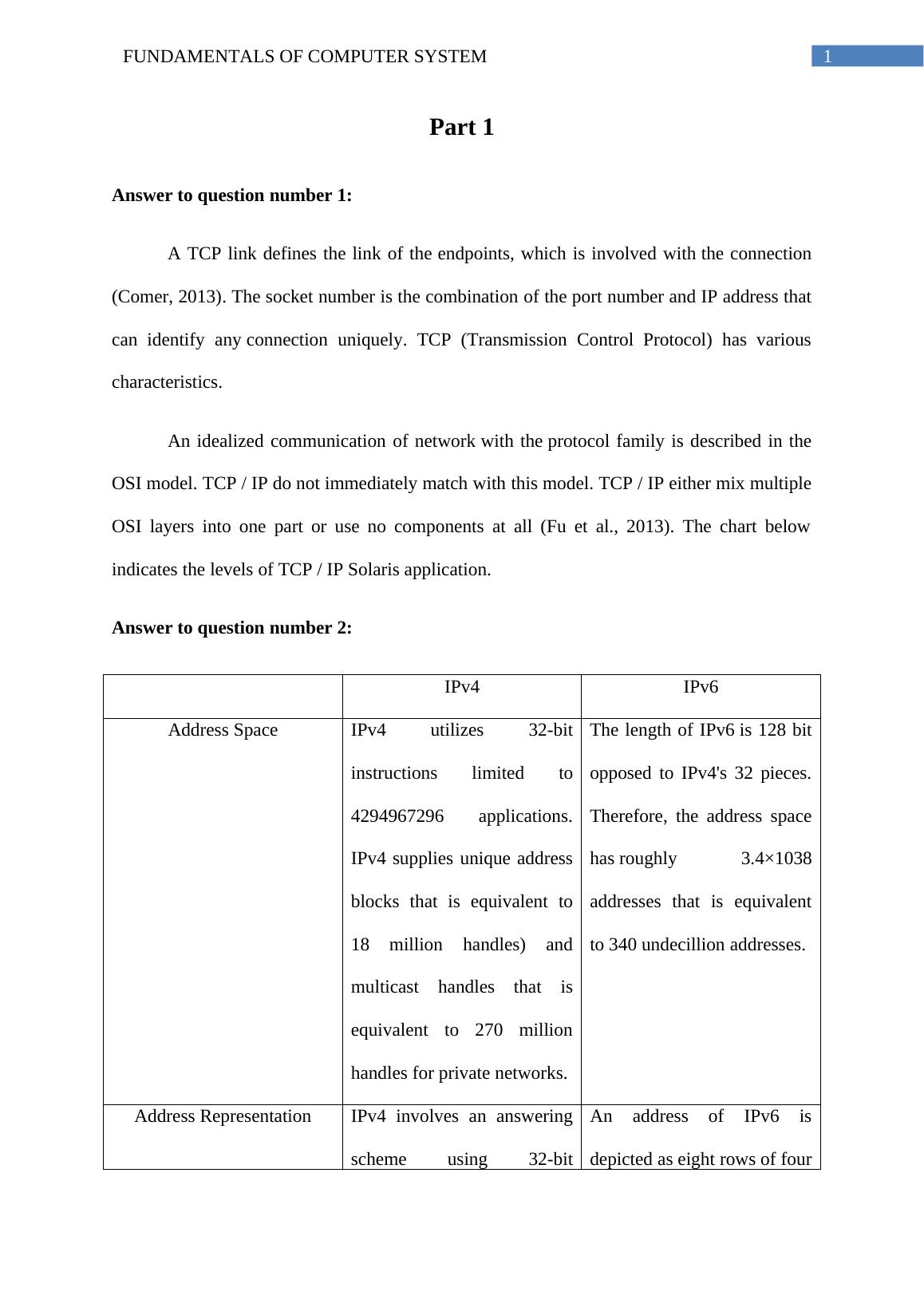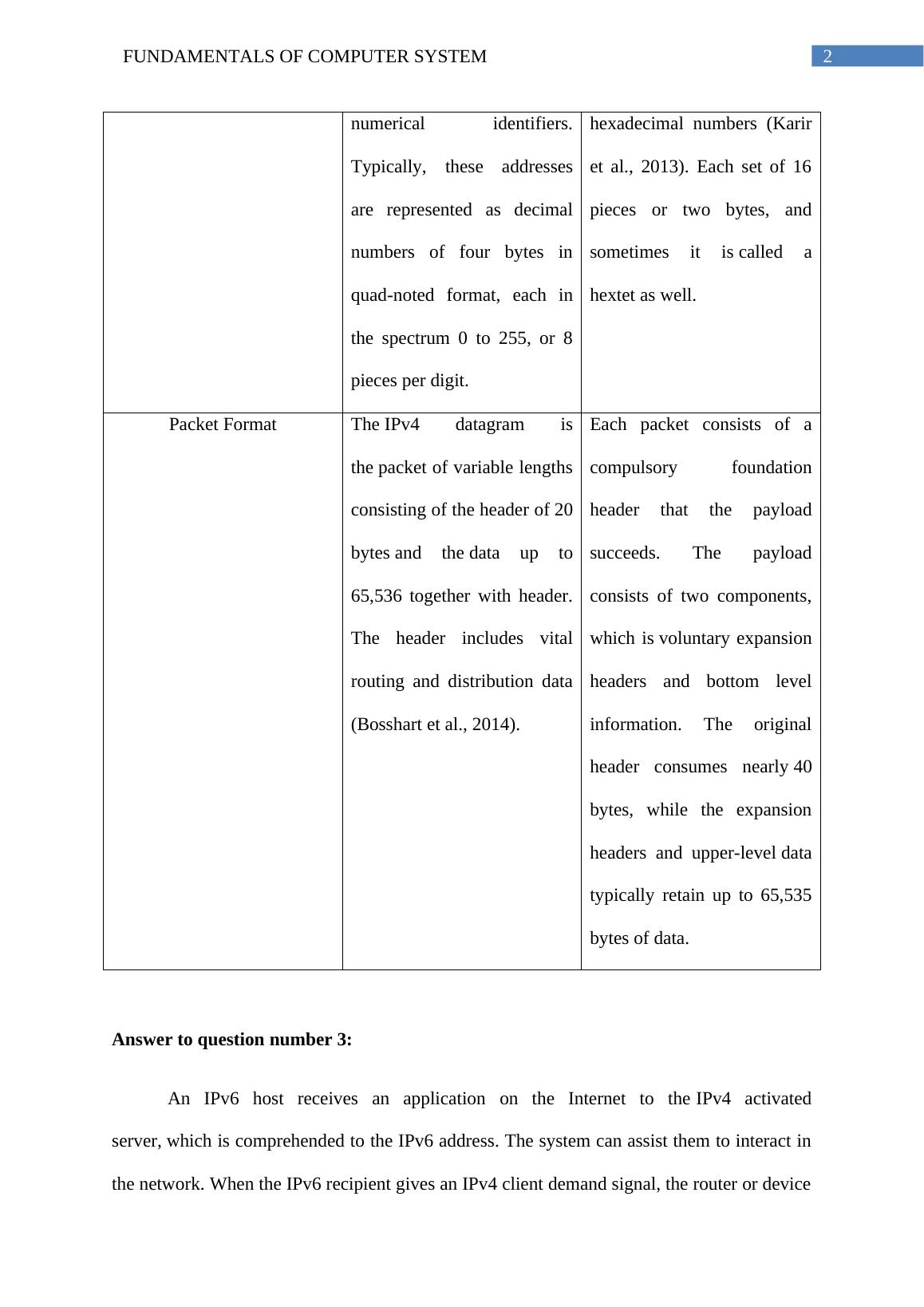Assignment On Fundamentals Of Computer System
Added on 2022-10-01
11 Pages2375 Words26 Views
Running head: FUNDAMENTALS OF COMPUTER SYSTEM
Fundamentals of Computer System
Name of the Student
Name of the University
Author Note
Fundamentals of Computer System
Name of the Student
Name of the University
Author Note

FUNDAMENTALS OF COMPUTER SYSTEM1
Part 1
Answer to question number 1:
A TCP link defines the link of the endpoints, which is involved with the connection
(Comer, 2013). The socket number is the combination of the port number and IP address that
can identify any connection uniquely. TCP (Transmission Control Protocol) has various
characteristics.
An idealized communication of network with the protocol family is described in the
OSI model. TCP / IP do not immediately match with this model. TCP / IP either mix multiple
OSI layers into one part or use no components at all (Fu et al., 2013). The chart below
indicates the levels of TCP / IP Solaris application.
Answer to question number 2:
IPv4 IPv6
Address Space IPv4 utilizes 32-bit
instructions limited to
4294967296 applications.
IPv4 supplies unique address
blocks that is equivalent to
18 million handles) and
multicast handles that is
equivalent to 270 million
handles for private networks.
The length of IPv6 is 128 bit
opposed to IPv4's 32 pieces.
Therefore, the address space
has roughly 3.4×1038
addresses that is equivalent to
340 undecillion addresses.
Address Representation IPv4 involves an answering
scheme using 32-bit
An address of IPv6 is
depicted as eight rows of four
Part 1
Answer to question number 1:
A TCP link defines the link of the endpoints, which is involved with the connection
(Comer, 2013). The socket number is the combination of the port number and IP address that
can identify any connection uniquely. TCP (Transmission Control Protocol) has various
characteristics.
An idealized communication of network with the protocol family is described in the
OSI model. TCP / IP do not immediately match with this model. TCP / IP either mix multiple
OSI layers into one part or use no components at all (Fu et al., 2013). The chart below
indicates the levels of TCP / IP Solaris application.
Answer to question number 2:
IPv4 IPv6
Address Space IPv4 utilizes 32-bit
instructions limited to
4294967296 applications.
IPv4 supplies unique address
blocks that is equivalent to
18 million handles) and
multicast handles that is
equivalent to 270 million
handles for private networks.
The length of IPv6 is 128 bit
opposed to IPv4's 32 pieces.
Therefore, the address space
has roughly 3.4×1038
addresses that is equivalent to
340 undecillion addresses.
Address Representation IPv4 involves an answering
scheme using 32-bit
An address of IPv6 is
depicted as eight rows of four

FUNDAMENTALS OF COMPUTER SYSTEM2
numerical identifiers.
Typically, these addresses
are represented as decimal
numbers of four bytes in
quad-noted format, each in
the spectrum 0 to 255, or 8
pieces per digit.
hexadecimal numbers (Karir
et al., 2013). Each set of 16
pieces or two bytes, and
sometimes it is called a
hextet as well.
Packet Format The IPv4 datagram is
the packet of variable lengths
consisting of the header of 20
bytes and the data up to
65,536 together with header.
The header includes vital
routing and distribution data
(Bosshart et al., 2014).
Each packet consists of a
compulsory foundation
header that the payload
succeeds. The payload
consists of two components,
which is voluntary expansion
headers and bottom level
information. The original
header consumes nearly 40
bytes, while the expansion
headers and upper-level data
typically retain up to 65,535
bytes of data.
Answer to question number 3:
An IPv6 host receives an application on the Internet to the IPv4 activated
server, which is comprehended to the IPv6 address. The system can assist them to interact in
the network. When the IPv6 recipient gives an IPv4 client demand signal, the router or device
numerical identifiers.
Typically, these addresses
are represented as decimal
numbers of four bytes in
quad-noted format, each in
the spectrum 0 to 255, or 8
pieces per digit.
hexadecimal numbers (Karir
et al., 2013). Each set of 16
pieces or two bytes, and
sometimes it is called a
hextet as well.
Packet Format The IPv4 datagram is
the packet of variable lengths
consisting of the header of 20
bytes and the data up to
65,536 together with header.
The header includes vital
routing and distribution data
(Bosshart et al., 2014).
Each packet consists of a
compulsory foundation
header that the payload
succeeds. The payload
consists of two components,
which is voluntary expansion
headers and bottom level
information. The original
header consumes nearly 40
bytes, while the expansion
headers and upper-level data
typically retain up to 65,535
bytes of data.
Answer to question number 3:
An IPv6 host receives an application on the Internet to the IPv4 activated
server, which is comprehended to the IPv6 address. The system can assist them to interact in
the network. When the IPv6 recipient gives an IPv4 client demand signal, the router or device

FUNDAMENTALS OF COMPUTER SYSTEM3
strips the IPv6 signal, takes the IPv6 protocol, provides the IPv4 protocol and transfers it over
the Internet. The router does the vice versa when an IPv4 server reaction goes to the IPv6
host.
Answer to question number 4:
The dual stack network is the network, where both IPv6 and IPv4 are allowed for all
the nodes. This is particularly crucial for the router, as a router is usually the first node to
the obtain requests from the outside of the network on the particular network. If data is
received by a node in the dual stack network and it is programmed for preferring the IPv6 to
IPv4 transport.
The network infrastructure can change from IPv4 to IPv6 for providing more space
for the addresses and represent increasing worldwide connectivity. One of the IPv4 to IPv6
transition approaches described in the latest years is dual stack networks in the IP addresses
transition.
Part 2
Answer to question number 1:
All the measures of information security try to address the three goals such as:
Protect confidentiality of the information
Preserve integrity of the information
Promote availability of the information for the authorized used
Three goals form the CIA triad (Confidentiality, integrity and availability), which are base of
all the security programs (Samonas & Coss, 2014).
strips the IPv6 signal, takes the IPv6 protocol, provides the IPv4 protocol and transfers it over
the Internet. The router does the vice versa when an IPv4 server reaction goes to the IPv6
host.
Answer to question number 4:
The dual stack network is the network, where both IPv6 and IPv4 are allowed for all
the nodes. This is particularly crucial for the router, as a router is usually the first node to
the obtain requests from the outside of the network on the particular network. If data is
received by a node in the dual stack network and it is programmed for preferring the IPv6 to
IPv4 transport.
The network infrastructure can change from IPv4 to IPv6 for providing more space
for the addresses and represent increasing worldwide connectivity. One of the IPv4 to IPv6
transition approaches described in the latest years is dual stack networks in the IP addresses
transition.
Part 2
Answer to question number 1:
All the measures of information security try to address the three goals such as:
Protect confidentiality of the information
Preserve integrity of the information
Promote availability of the information for the authorized used
Three goals form the CIA triad (Confidentiality, integrity and availability), which are base of
all the security programs (Samonas & Coss, 2014).

End of preview
Want to access all the pages? Upload your documents or become a member.
Related Documents
IT Fundamentals | Assignmentlg...
|11
|1801
|17
Fundamental of Computer Systemlg...
|11
|2560
|288
Networking Fundamentalslg...
|7
|1169
|201
Fundamentals of ITlg...
|7
|1319
|244
Intermediate Computer Networking: Part Blg...
|9
|2022
|441
Communication Networks - Assignment 1 Solutionslg...
|6
|642
|484
